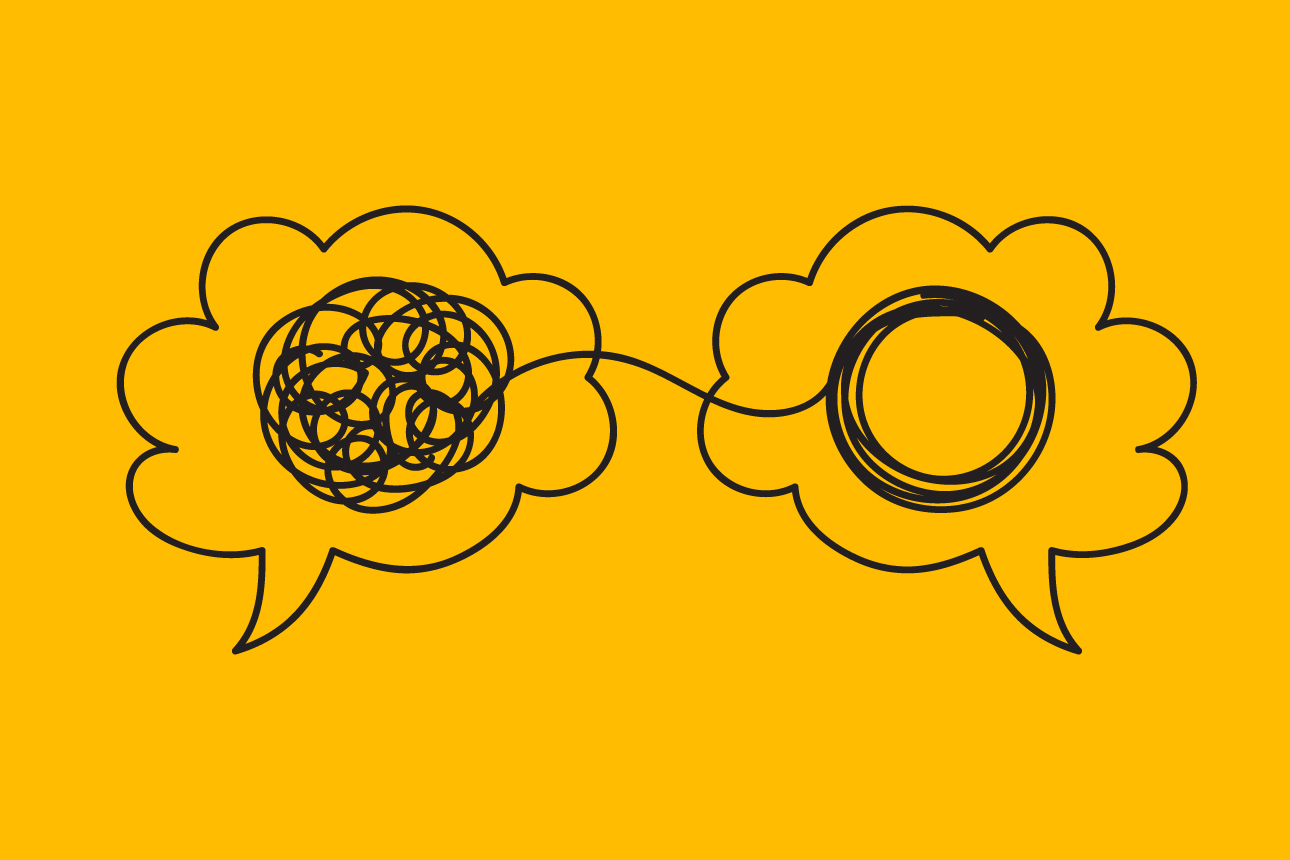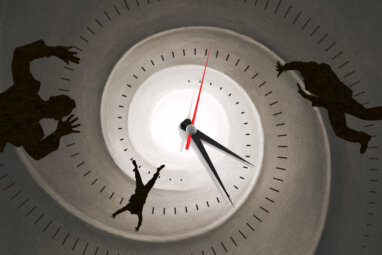Easing the Invisible Burdens of Collaboration
A new book delves into collaboration practices and offers creative suggestions to transform them.

Collaboration is essential in today’s work world, but it can also consume more time and energy than well-intended leaders expect or recognize. What precisely do we need in collaborative interactions, what are we trying to get out of them, and how can we optimize our time together? Author and MIT Sloan Management Review contributor Rob Cross, the Edward A. Madden Professor of Global Leadership at Babson College, explores these questions in his new book, Beyond Collaboration Overload: How to Work Smarter, Get Ahead, and Restore Your Well-Being (Harvard Business Review Press).
Deborah Milstein, associate editor at MIT SMR, recently spoke with Cross about his book and his work on organizational network analysis, a methodology that maps the often invisible informal working relationships through which collaborative work typically gets done. What follows is an edited and condensed version of their conversation.
MIT Sloan Management Review: Everyone needs to collaborate to some extent to do their jobs, but in your book, you discuss how the wrong types of collaboration can actually interfere with people’s ability to get their work done efficiently. What did your research uncover about why people can end up feeling so overwhelmed by something that’s intended to be helpful, and why collaborative overload has been increasing?
Rob Cross: It actually started over a decade ago. By applying network analysis across all organizations, regardless of company size, you could consistently see that both the number of collaborative demands and the diversity of them were overwhelming people.
In general, what so many efficiency efforts did — whether they were cultural interventions, or formal structure designs, or new technologies — was force more and more collaborations on people at a threshold transcending what was quantitatively reasonable. You started to see burnout metrics go up, but there was no understanding of the collaborative footprint of what was asked.
A task may look easy on the project plan, but if it requires you to coordinate across three time zones with two leaders who dislike one another to secure resources from somebody with misaligned incentives — that’s huge in terms of time. And that’s what’s been invisible.
Even the most efficient collaborators I interviewed were stretched beyond belief. I found this over and over in interviews, and as I started to understand what this overload is doing to people, it became meaningful on a personal level, too. People are overwhelmed — and it’s not going to get better, given this perpetual move toward greater collaboration and enterprise connectivity. We can track expense receipts down to two decimal places because of the sophistication of our systems, but organizations have to become more sophisticated at seeing the actual collaborative footprint of work. And people must be better equipped to manage collaboration in this hyper-connected world.
Throughout the book you come back to the example of Scott, a well-meaning, highly relational executive involved in too many things, who unintentionally became a consistent bottleneck. What should folks do when there’s a leader who’s creating an organizational problem through their collaboration practices?
Cross: Every time there’s a collaborative dysfunction, everybody points to the leaders. The tendency is to say, “They’re micromanaging” or “They’re not in control of the situation.” Scott had become a bottleneck — but not for reasons that people would have thought.
We’re all conditioned to think collaborative overload is out there — something external to us. So we miss the ways in which we jump in because of our need for accomplishment or status, or our fear, or something else internal that’s driving us.
For Scott, it was this huge desire to help that led him to insert himself, solely because he felt that he had to let his team know he was there, which is what he’d always done as a servant-leader. But his involvement generated second-order interactions and more meetings, and eight weeks later, he’d be overwhelmed.
In everything I write about collaborative overload, people always ask, “What’s the one thing we need to do?” There’s no “one thing,” though that’s a seductive principle. Rather, we find that people who succeed today pursue three or four behaviors dogmatically to buy back time.
Confronting someone about their behavior at work can be very uncomfortable, especially for a more junior-level employee. How can you tactfully approach a colleague in this situation?
Cross: As part of the book, I created an online diagnostic that we make available for free to help people identify three things that they should focus on. No two people pick the same things because they have different constellations of things they need to do.
You can use this diagnostic with your teams to discuss what you should be holding each other accountable for — and it’s a lot easier than saying to a leader, “Look, you’re doing this problematic thing.” When you discuss these ideas in a constructive way, people suddenly recognize these unintended patterns they created — and they’re just as happy to get out of the patterns as everyone around them.
Reducing collaborative overload can buy back typically 18% to 24% of your time. But it’s not just the time savings that matters — it’s what you then do with that freed-up time that enables you to scale and to collaborate differently.
There’s so much confusion between modes of communication — the meeting channel and the email channel, for example. You mention the example of Reina, who had once casually told someone, “Email me about issues,” but then she didn’t actually read the email that her employee spent all this time writing.
Cross: So many of the inefficiencies we encounter are built into the cultures of use — how people get used to employing the tools we have around us. But one of the quickest and easiest things anybody can do is start a process of determining better practices for each mode of collaboration.
Whether you’re a part of a team or a team leader, create a simple three-column sheet — on a piece of paper, Excel, anything. The goal is to consider the modalities that you’re using — say, Zoom, email, and Slack, or whatever tools that you most use — and collectively answer three questions for each modality. In the first column, answer, “What are the five positive things we want to do in these modalities?” In the second column, “What are the practices we want to agree to?” And in the third column, “What do we not want to do to each other?”
For example, you don’t want to get or send a 12-paragraph email with key information in the 11th paragraph. No one can get through that. People can work well together if they eliminate confusion about usage and can agree to whatever will work for the team — maybe that’s putting up front what the main message is or using bullet points versus paragraphs.
What is the value of meetings in this moment of hybrid and remote work?
Cross: What we know is that meetings matter. Virtual interactions are fine for things like project management, status updates, and information sharing. But organizational network analysis reveals that people generally prefer in-person interactions for three things: the times that we need growth and development, the times we need purpose and energy, and the times we need innovation.
But that doesn’t just mean serendipity, and it’s bigger than “watercooler moments.” This kind of interaction is not necessarily a skill that’s built with leaders today. They may have learned to run great project status meetings with flip charts, and they may be excited to get everybody back to the office so they can keep doing what they’re comfortable with and see people’s reactions. But is that the best use of people’s time? We need to think more, and more carefully, about what we’re bringing into these meeting formats and what can be made more efficient.
I appreciated that your book distinguishes between having a big network and a meaningful network. What’s your suggested long-term approach to building a network, and how does that connect to being in the office?
Cross: The idea of having a big network, just knowing a lot of people, only works in highly transactional fields where more volume pays off, like residential real estate sales. In contrast, structurally diverse networks enable people to be better performers and better innovators over time.
Generally speaking, the better performers tend to invest about 20% more time, weekly or monthly, in exploring possibilities with others. They understand the importance of long-term networking, and they connect to say things like, “I’d like to get a better sense of how you work so that when I’m passing things over, maybe we can do things better.” The approach totally changes the nature of the responses you get — but only if you preserve that time to build relationships and explore and discover synergies.
This habit of long-term network development is mainly about being intentional and thinking about the capabilities you want to be using in the future or how you want to deliver value, and deliberately starting to connect with others [who] can pull you in that direction over time.
But there is absolutely something special about face-to-face, in-the-moment interactions, and going through these interviews I heard some cool stories of people re-creating serendipity — that watercooler idea.
Do you have an example of how a team was able to connect on that level despite being physically distanced from one another?
Cross: One of my favorites was from a Wall Street investment banker [who] led a group of very skeptical investment bankers. After everyone suddenly went remote in 2020, he said to his wife, “I don’t have a sense of what the group’s doing or what they’re working on. I’ve lost my dashboard to see if people are stressed or if things are OK.”
His wife suggested the “Friday rose” exercise. On every Friday, have people write their “stem,” the thing they learned this week or how they grew in some way; their “rose,” the cool thing that happened that week; and finally, the “thorn,” the thing that didn’t go right, or got messed up, or they wish they’d done differently.
He told me, “The first Friday, I sent the rose exercise out to 20 people, and I could just feel them laughing at me. But I made them do it, so everybody responded — and within two or three weeks, it became a norm.” It was a great example of created serendipity that allowed people to connect and see new collaboration possibilities differently. Also, sharing “thorns” started to create trust, because people in the group had to be a bit vulnerable; they could choose whatever level of information they wanted to share, but they had to say something.
And that’s the level that we’ve got to get to in the next phase of work. It’s important to think about what conditions or tools you need for innovation — and I don’t think it’s the actual moment at the physical watercooler but something you can create virtually if momentum builds behind the idea. If you and I have an idea in the same space, and we get someone else involved to contribute ideas, it starts to build momentum — and that’s a more critical piece of the office space calculation, who you’re going to connect with and what you’ll do together.








